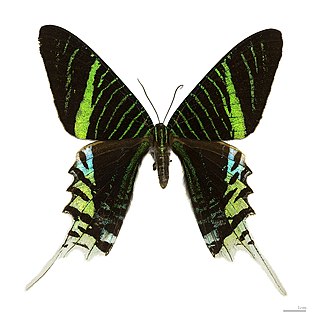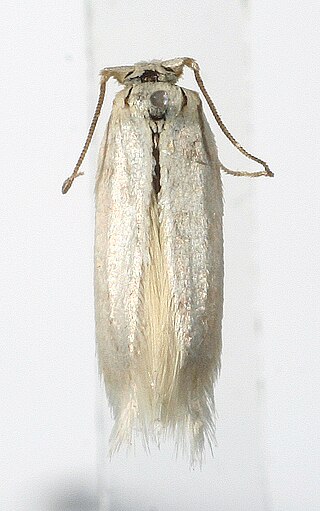Related Research Articles

Lepidoptera or lepidopterans is an order of winged insects that includes butterflies and moths. About 180,000 species of the Lepidoptera have been described, representing 10% of the total described species of living organisms, making it the second largest insect order with 126 families and 46 superfamilies, and one of the most widespread and widely recognizable insect orders in the world.

Moths are a group of insects that includes all members of the order Lepidoptera that are not butterflies. They were previously classified as suborder Heterocera, but the group is paraphyletic with respect to butterflies and neither subordinate taxon is used in modern classifications. Moths make up the vast majority of the order. There are approximately 160,000 species of moth, many of which have yet to be described. Most species of moth are nocturnal, although there are also crepuscular and diurnal species.

The Sphingidae are a family of moths commonly called sphinx moths, also colloquially known as hawk moths, with many of their caterpillars known as "hornworms"; it includes about 1,450 species. It is best represented in the tropics, but species are found in every region. They are moderate to large in size and are distinguished among moths for their agile and sustained flying ability, similar enough to that of hummingbirds as to be reliably mistaken for them. Their narrow wings and streamlined abdomens are adaptations for rapid flight. The family was named by French zoologist Pierre André Latreille in 1802.

The geometer moths are moths belonging to the family Geometridae of the insect order Lepidoptera, the moths and butterflies. Their scientific name derives from the Ancient Greek geo γεω, and metron μέτρον "measure" in reference to the way their larvae, or inchworms, appear to measure the earth as they move along in a looping fashion. Geometridae is a very large family, containing around 23,000 described species; over 1400 species from six subfamilies are indigenous to North America alone. A well-known member is the peppered moth, Biston betularia, which has been the subject of numerous studies in population genetics. Several other geometer moths are notorious pests.

The Arctiinae are a large and diverse subfamily of moths with around 11,000 species found all over the world, including 6,000 neotropical species. This subfamily includes the groups commonly known as tiger moths, which usually have bright colours, footmen, which are usually much drabber, lichen moths, and wasp moths. Many species have "hairy" caterpillars that are popularly known as woolly bears or woolly worms. The scientific name Arctiinae refers to this hairiness. Some species within the Arctiinae have the word "tussock"' in their common names because they have been misidentified as members of the Lymantriinae subfamily based on the characteristics of the larvae.

The Uraniidae are a family of moths containing four subfamilies, 90 genera, and roughly 700 species. The family is distributed throughout the tropics of the Americas, Africa and Indo-Australia. Some of the tropical species are known for their bright, butterfly-like colors and are called sunset moths. Such moths are apparently toxic and the bright colors are a warning to predators.

The Drepanidae are a family of moths with about 660 species described worldwide. They are generally divided in three subfamilies, which share the same type of hearing organ. Thyatirinae, previously often placed in their own family, bear a superficial resemblance to Noctuidae. Many species in the drepanid family have a distinctively hook-shaped apex to the fore wing, leading to their common name of hook-tips.

Gelechioidea is the superfamily of moths that contains the case-bearers, twirler moths, and relatives, also simply called curved-horn moths or gelechioid moths. It is a large and poorly understood '"micromoth" superfamily, constituting one of the basal lineages of the Ditrysia.

Castniidae, or castniid moths, is a small family of moths with fewer than 200 species: The majority are Neotropical with some in Australia and a few in south-east Asia. These are medium-sized to very large moths, usually with drab, cryptically marked forewings and brightly coloured hindwings. They have clubbed antennae and are day flying, and are often mistaken for butterflies. Indeed, some previous classification systems placed this family within the butterflies or skippers. The Neotropical species are commonly known as giant butterfly-moths, the Australian and Asian species as sun moths. The larvae are internal feeders, often on roots of epiphytes or on monocotyledons.

The Dalceridae are a small family of zygaenoid moths with some 80 known species encompassing about one dozen genera mostly found in the Neotropical region with a few reaching the far south of the Nearctic region.

The Arctiini are a tribe of tiger moths in the family Erebidae.

Incurvariidae is a family of small primitive monotrysian moths in the order Lepidoptera. There are twelve genera recognised. Many species are leaf miners and much is known of their host plants, excluding Paraclemensia acerifoliella. The most familiar species in Europe are perhaps Incurvaria masculella and Phylloporia bistrigella. The narrow wings are held tightly along the body at rest and some species have very long antennae.

Brachodidae is a family of day-flying moths, commonly known as little bear moths, which contains about 135 species distributed around much of the world. The relationships and status of the presently included genera are not well understood.

The Glyphipterigidae are a family of small moths commonly known as sedge moths, as the larvae of many species feed on sedges and rushes. More than 500 species have been described in the family.

Opostegidae or "white eyecap moths" is a family of insects in the order Lepidoptera that is characterised by particularly large eyecaps over the compound eyes. Opostegidae are most diverse in the New World tropics.

Glossata is a suborder of the Lepidoptera, containing all members that have a coilable proboscis; i.e., it includes all butterflies and the vast majority of moth species. The only non-Gloassatan moths are in the suborders Aglossata, Heterobathmiina, and Zeugloptera.

Heteroneura is a natural group in the insect order Lepidoptera that comprises over 99% of all butterflies and moths. This is the sister group of the infraorder Exoporia, and is characterised by wing venation which is not similar or homoneurous in both pairs of wings. Though basal groups within the Heteroneura cannot be identified with much confidence, one major subgroup is the leaf-mining Nepticuloidea. Species in this subgroup include some of the smallest lepidopterans identified.

Geometrinae is the nominate subfamily of the geometer moth family (Geometridae). It is strongly split, containing a considerable number of tribes of which most are presently very small or monotypic. These small moths are often a light bluish green, leading to the common name of emerald moths, though a few species called thus are also found in the tribe Campaeini of the Ennominae. In 2018, a phylogeny and classification based on a molecular phylogenetic analysis was published in the Zoological Journal of the Linnean Society in which 13 tribes were accepted.

The Baltic region is home to the largest known deposit of amber, called Baltic amber or succinite. It was produced sometime during the Eocene epoch, but exactly when is controversial. It has been estimated that these forests created more than 100,000 tons of amber. Today, more than 90% of the world's amber comes from Kaliningrad Oblast of Russia. It is a major source of income for the region; the local Kaliningrad Amber Combine extracted 250 tonnes of it in 2014 and 400 tonnes in 2015.

The Thyatirinae, or false owlet moths, are a subfamily of the moth family Drepanidae with about 200 species described. Until recently, most classifications treated this group as a separate family called Thyatiridae.